



The 450 Noma Talking Station was made in the 1950s by Noma Lites – a Christmas light company to go with Lionel and American Flyer trains. The mechanism was powered by two regular D batteries.
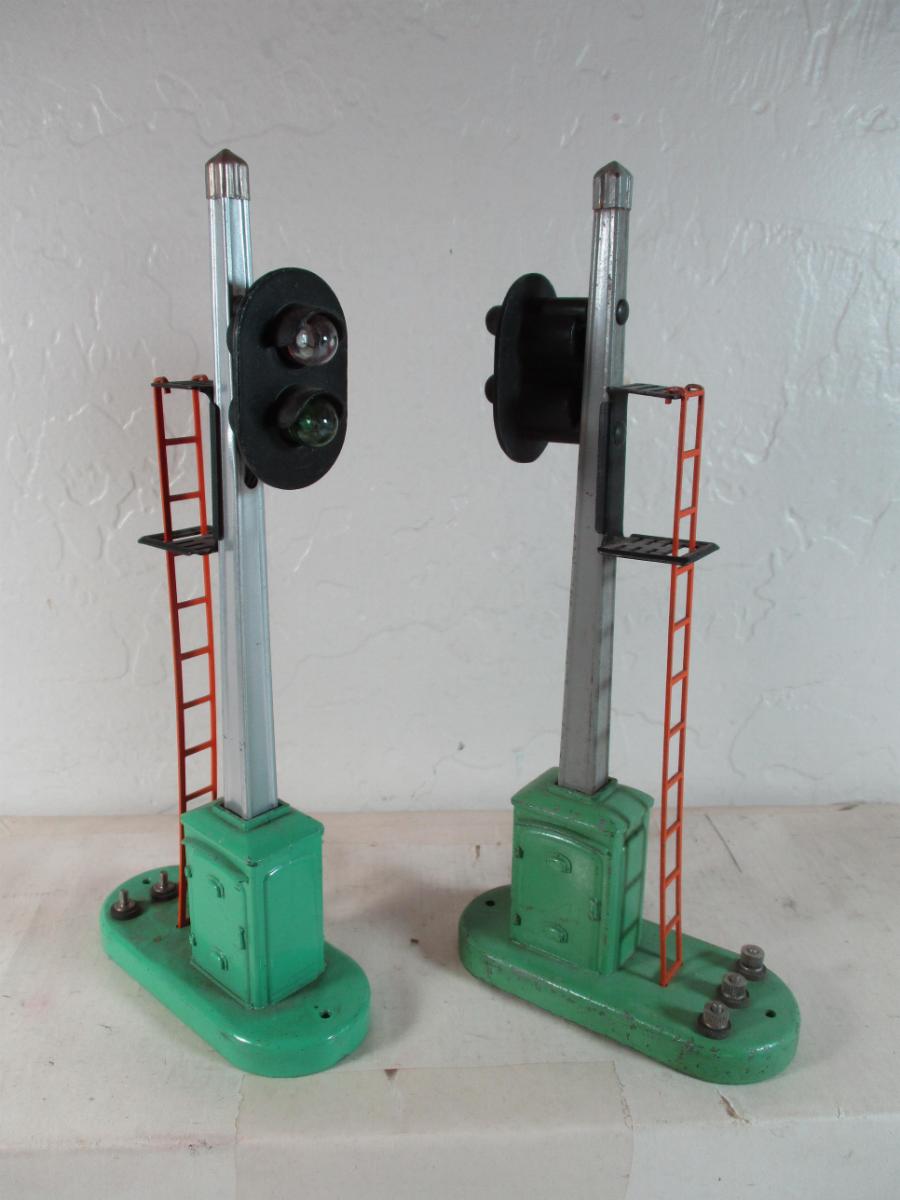
Lionel introduced the 153 Block signal in 1940. The signal features a green die-cast metal base, a sheet metal or later aluminum pole and a die-cast metal lamp head. The signal was sold until production stopped for the war in 1942. Then it was sold again after the war from 1945-59.
Here’s something interesting, a book of matches from about 1960. The Earnest Machine Products Company offers a free set of trains for the purchase of White Diamond plow bolts. Buy 2000 1/8 inch diameter bolts or 1000 larger size bolts, or any similar sized order and the Earnest will give you a set of Lionel Trains.
Note the Lionel train set on the matches themselves and the handy advice not to mail the matches. The artwork for the train set does not show a tender. I think this means Lionel did not create the artwork for this promotion. It looks like a cheap starter set.
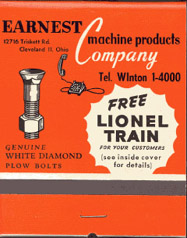
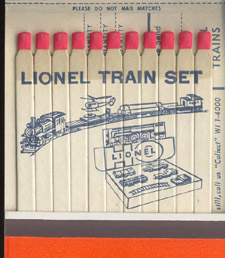
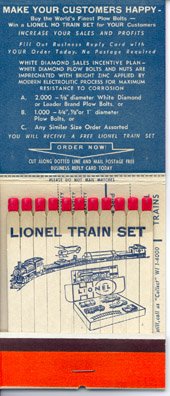
Lionel gave employees gifts to recognize service. Below are shown a five year and a ten year employee pin. Employee service pins are very rare. These pins featured a steam engine and inserted cloisonné lettering.
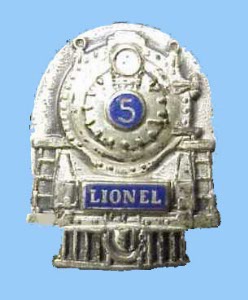
Lionel Five year pin.
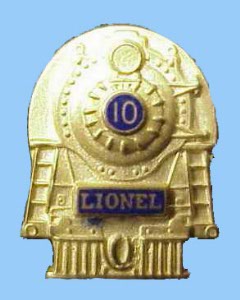
Lionel ten year pin.
In the late 1950s these interesting cardboard displays were included in boxes of Nabisco’s Shredded Wheat cereal. Young boys must have badgered their mothers for cereal so they could add to their collections.
Different scenes were made featuring various Lionel Locomotives. Here are three of them.
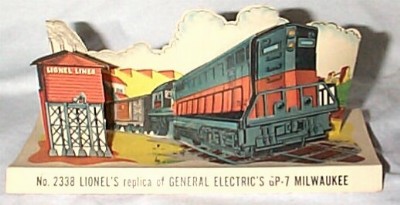
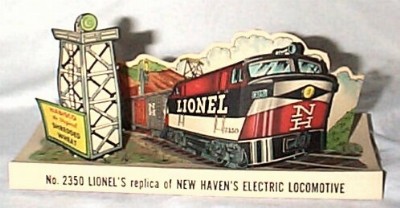
Lionel 2350 New Haven EP-5 Electric Locomotive
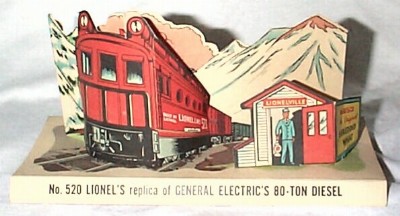
Lionel 520 Box Cab Electric
Lionel Postwar Trains
The Lionel trains made between 1945 and 1969 are called Postwar trains. This terminology defines Lionel production very well. Trains were not made during the war, and Lionel changed hands in 1970. Trains made between 1945 and 1969 are called postwar trains.
Lionel took advantage of the production gap to introduce their new operating knuckle couplers. All Lionel postwar trains except the short lived Lionel Scout series had the famous cast knuckle couplers. Lionel had begun moving towards more realistic model trains in the late 1930s. In the postwar period Lionel continued the trend to realistic models.
The biggest postwar innovation was the introduction of smoke in 1946. Within a few years all Lionel locomotives except the cheapest starter sets had smoke. Lionel postwar accessories featured men who did things. Opened car doors, threw out milk cans and mail bags, unloaded and loaded barrels, loaded ice and many other interesting activities.
Lionel’s postwar offerings were model trains you could play with.
The Russian train set was made in the late 1950’s and early 60’s. At least I think so because there are dates or at least things that could be dates rubber-stamped on the bottoms of all the items. This was sold as a set with all the items shown below and a bridge and crossing gate not shown.
The track is numbered with riveted on metal tags. You start with the section numbered one and connect number two to it and so on until you have set up the entire layout. There are wire harnesses that clip
to the track and have plugs similar to the type found on Marklin HO trains.
All the contents appear to be copies of toy trains made by other manufacturers. Oddly the Russians did not copy new trains, they copied older items. This could be because their technology was better suited
to making trains with 20-year-old manufacturing methods.
The die casting of the engine is very well executed, and the overall construction is superb. These could be the only toy trains produced in a command economy. Obviously the profit motive was not a factor in
the design.
As far as I know after 1948 no American company made complete ready to run train sets that included accessories except Marx’s low cost train sets and the failed All Aboard train sets made by American Flyer in the 1960’s.
The accessories included with the Russian train were not available separately. However, there does seem to be a lot more accessories out there than trains. This could be because the trains were thrown out instead of being repaired and the accessories were then used with other trains.
Note: The pictures are not to scale. Engine is actually longer than the passenger cars.
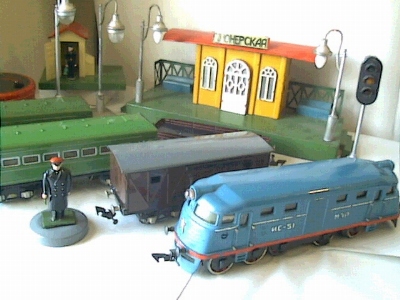
This is the set with a few extra items added.
The Station.<
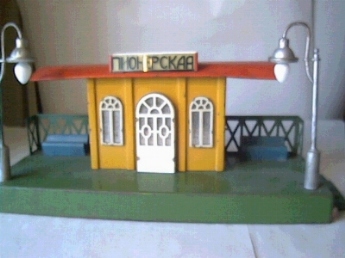
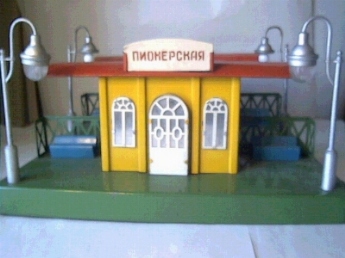
The station has a bell inside it and light. The station has punched out widows with nice sheetmetal frames in them. They look like they were designed to hold glass in the frames. There is no glass in the
frames though. There is, however, plated sheetmetal in the frames. Note sheetmetal, unlike glass is NOT transparent. So why is there a bulb inside?
I used to joke with my dad when he had only one station to
look at that it must be because they were designed by a committe. One person wanted a lighted station, while another thought the shiney metal looked good so they compromised and did both! My dad suggested it was because they were made in Communist Russia and the guy who added the bulb to the station needed the job.
Only one station came with the set. The station on the left should have light covers like the upper station on the streetlights.
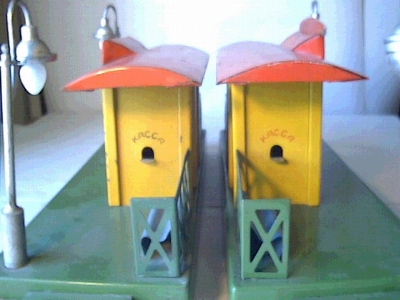
These small holes are the only place light can come out of the station. Notice black lettering on one and red on other.
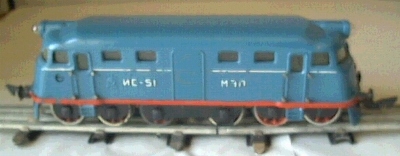
The engine is a big blue 12 wheeled diesel locomotive. It is diecast metal. Only the four inner wheels are powered. The loco can also be found in brown or green.
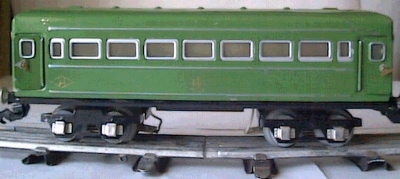
The set came with two of these green coaches. There is a variation of the lettering and the color changes to a brighter shade in the later trains.
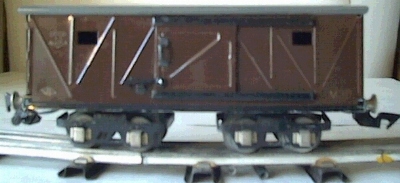
Only one of boxcar came in the set. There are probably variations in the lettering, but with only the one shown to look at I can’t make any statements. The door slides. All cars have die cast metal wheels with
oversized flanges, and couplers similar to American Flyer Link and Pin style couplers.
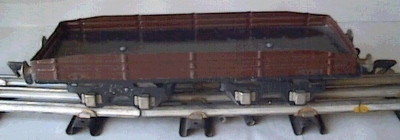
One flatcar came in each set. This car comes in two shades of brown. Only one is shown. I don’t know if this car came with a load.
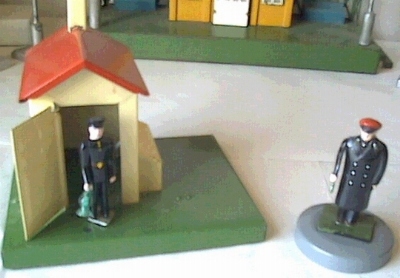
The Gateman is a copy of a Lionel 45 gateman introduced in 1935. When a train goes past the man comes out and waves at traffic. It does not have warning sign like Lionel’s version. The Flagman is a smaller copy of the Lionel 1045 Flagman introduced in 1938. Like the Gateman there is not a crossing sign.
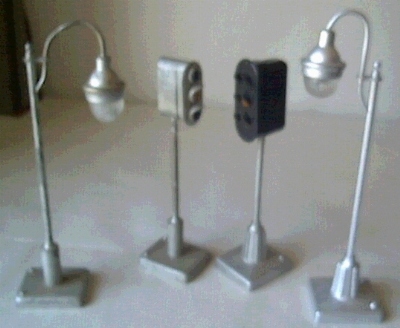
I don’t know how many of each came with a set. Two different bases were made over the years. The block signal also came with two different heads. The streetlight has a glass bowl over the bulb to give it the shape you see in the photo.
The Transformer is rated at 75 watts and runs on 127 volts 50 cycle current. The output is 5 to 13 volts AC for the train and 13 volts for the accessories.This is a beautiful set of trains with an interesting history.
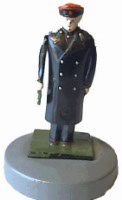
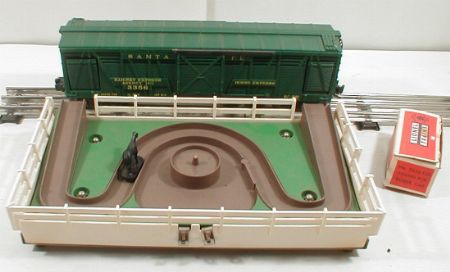
Lionel introduced the 3356 operating horse car and corral set in 1956. It ran until 1960 when it was dropped from the catalog. It reappeared in the catalog in 1964, and ran through 1966. There are no variations.
The horse car and corral are used together. When the car is positioned as shown above the doors open and horses go in and out of the car. This accessory works much better than the earlier 3656 operating cattle car.

The corral was offered separately as a replacement item. The box for just the corral is worth more than the entire set. The rare box says 3356-150 and holds ONLY the corral. The 3356 box that holds both the car and corral is quite common.
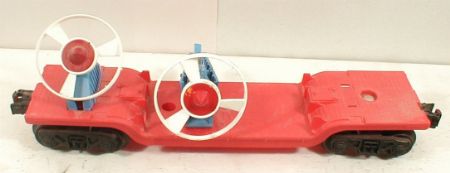
The 3309 is an uncataloged car and doesn’t have a number on it. At least three variations were made. The one shown above is the most common. The car is also found on a darker red flatcar or a drab olive flatcar.
The 3309 turbo missile launching flatcar in red comes with or without the holder for the extra missile shown on the right side of the car above.
All versions of the 3309 flatcar are equally common except the drab olive which is quite rare.